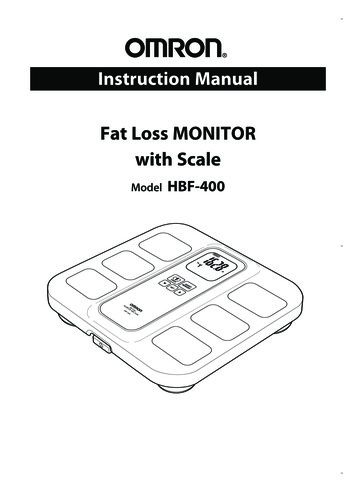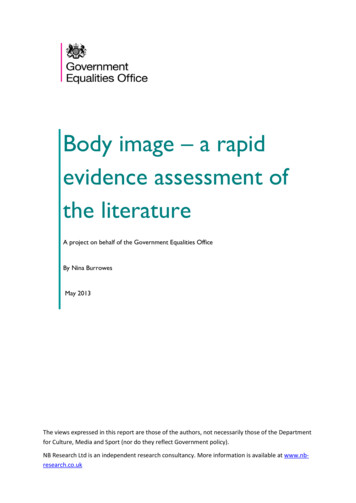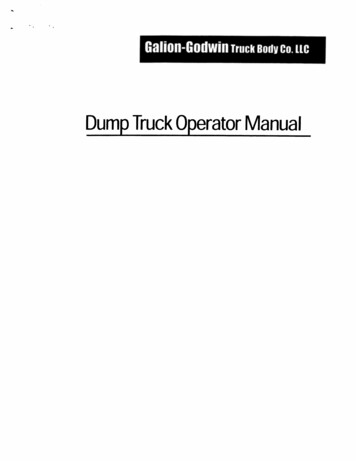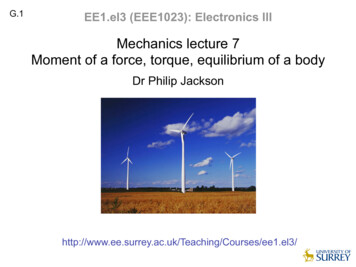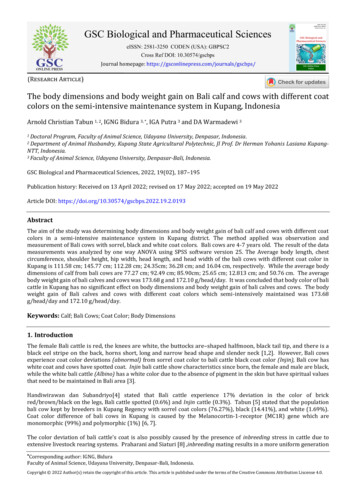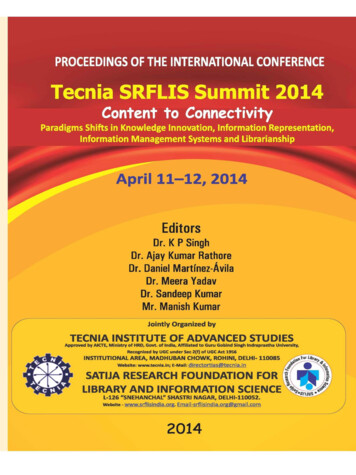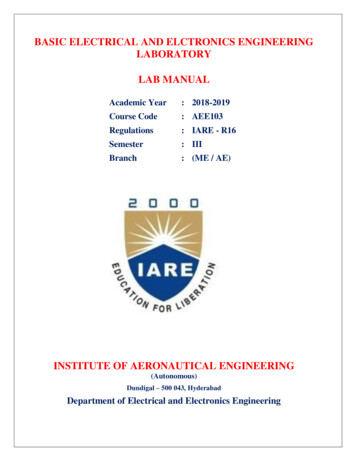
Transcription
Professional Engineering Body of KnowledgePrepared by the Licensure and Qualifications for PracticeCommittee of the National Society of Professional Engineersfirst edition, 2013
Professional Engineering Body of KnowledgePrepared by theLicensure and Qualifications for Practice Committeeof theNational Society of Professional EngineersFirst Edition, 2013
ContentsExecutive SummaryThe Body of Knowledge Concept .4The Engineering Body of Knowledge .4Uses of the Engineering Body of Knowledge .5Chapter 1 IntroductionNSPE’s Vision, Mission, and Values .6Charge Undertaken by the NSPE Licensure andQualifications for Practice Committee .6The Process Used .7Chapter 2 The Body of Knowledge ConceptDefinitions .9Uses of the Engineering Body of Knowledge .9Chapter 3 The Professional Engineer of the FutureGuiding Principles that Will Shape the Future of Engineering .11Key Attributes of the Professional Engineer of the Future .12Chapter 4 The Engineering Body of KnowledgeDefinition of Entry into Professional Engineering Practice .13Use of Capabilities to Describe the Body of Knowledge .13Overview of the Capabilities .14Chapter 5 The Next Steps .19Acknowledgements .20APPENDIX A Abbreviations .21APPENDIX B National Society of Professional Engineers Licensure andQualifications for Practice Committee 2012–13 .242
APPENDIX C Engineering Disciplines .26APPENDIX D The Body of Knowledge Necessary for Entry into the ProfessionalPractice of Engineering Expressed as CapabilitiesBasic or Foundational Capabilities .28Technical Capabilities .32Professional Practice Capabilities .48APPENDIX E Notes .593
Executive SummaryThe National Society of Professional Engineers (NSPE) Engineering Body of Knowledge (BOK)initiative was undertaken in support of the Society’s vision, mission, and values and inrecognition of the need to proactively prepare for and participate in continuous changes intechnological, social, cultural, political, and economic conditions. The charge undertaken byNSPE’s Licensure and Qualifications for Practice Committee (LQPC) included reviewing recentkey publications and then developing, while interacting with various stakeholders within andoutside of NSPE, an Engineering BOK common to all engineering disciplines.As suggested by the charge and consistent with NSPE’s vision, mission, and values, theEngineering BOK project and the resulting report are about the future. Given the uniqueness ofthis effort, including its future orientation and its intent to encompass all engineering disciplines,this report should be viewed as an aspirational and living document. It stimulatedinterdisciplinary discussions during its preparation and is expected to encourage continuedconversations now that it is published and widely available. Those interactions are very likely toeventually require a subsequent edition of the Engineering BOK.The Body of Knowledge ConceptA profession’s BOK is its common intellectual ground—it is shared by everyone in theprofession regardless of employment or engineering discipline. The Engineering BOK, as used inthis report, is defined as the depth and breadth of knowledge, skills, and attitudes appropriate toenter practice as a professional engineer in responsible charge of engineering activities thatpotentially impact public health, safety, and welfare. Within the BOK: Knowledge consists of comprehending theories, principles, and fundamentals; Skills are the abilities to perform tasks and apply knowledge; and Attitudes are the ways in which one thinks and feels in response to a fact or situation.In broad terms, knowledge is what one knows in a fundamental sense, skill is what one is able todo with what one knows, and attitude is how one responds to a variety of situations.The Engineering Body of KnowledgeFor the purposes of the Engineering BOK, the knowledge, skills, and attitudes are referred to as―capabilities.‖ A capability is defined as what an individual is expected to know and be able todo by the time of entry into professional practice in a responsible role. A given capabilitytypically consists of many diverse and specific abilities.4
Each capability is usually acquired by a combination of engineering education and experience.NSPE will not be ―teasing apart‖ what aspects or parts of the capabilities are fulfilled througheducation or experience because these means may vary significantly across disciplines andemployment circumstances.The names of 30 capabilities comprising the recommended Engineering BOK are listed here.They are organized for clarity into three categories, namely, Basic or Foundational, Technical,and Professional Practice. To reiterate, these are the names of the capabilities. The names are justthat, they do not describe the capabilities. Refer to Appendix D for a description of eachcapability along with examples of supporting abilities.Basic or Foundational Capabilities: 1. Mathematics, 2. Natural Sciences, 3. Humanitiesand Social SciencesTechnical Capabilities: 4. Manufacturing/Construction, 5. Design, 6. EngineeringEconomics, 7. Engineering Science, 8. Engineering Tools, 9. Experiments, 10. ProblemRecognition and Solving, 11. Quality Control and Quality Assurance, 12. Risk,Reliability, and Uncertainty, 13. Safety, 14. Societal Impact, 15. Systems Engineering,16. Operations and Maintenance, 17. Sustainability and Environmental Impact, 18.Technical Breadth, 19. Technical DepthProfessional Practice Capabilities: 20. Business Aspects of Engineering, 21.Communication, 22. Ethical Responsibility, 23. Global Knowledge and Awareness, 24.Leadership, 25. Legal Aspects of Engineering, 26. Lifelong Learning, 27. ProfessionalAttitudes, 28. Project Management, 29. Public Policy and Engineering, 30. TeamworkWhile the full BOK is intended to apply across the engineering profession, each engineeringdiscipline and employment situation combination may focus on a certain subset of thecapabilities. Preparing a profession-wide BOK for a profession as diverse as engineering ischallenging and worthwhile.Uses of the Engineering Body of KnowledgeThe recommended Engineering BOK can be useful, in a variety of ways, to various members ofthe profession and those with whom they interact; it is not an abstract concept. More specifically,the Engineering BOK can be of value to prospective and current engineering students, engineerinterns and professional engineers, engineering mentors and supervisors, employers, engineeringand other faculty, accreditation leaders, and licensing and certification boards.In preparing, publishing, and widely distributing this document NSPE hopes that individuals,such as those just listed here, and their organizations will be motivated to examine where theyhave been, are, and could go. More specifically, NSPE asks each engineering discipline to usethe Engineering BOK as another means of engaging its stakeholders in assessing the discipline’sstatus and challenges and then contemplating options for moving forward to meet thosechallenges.5
Chapter 1IntroductionNSPE’s Vision, Mission, and ValuesThe Vision1 of the National Society of Professional Engineers (NSPE) is to be ―the recognizedvoice and advocate of licensed Professional Engineers.‖ In partnership with the State Societies,NSPE’s Mission1 is to be ―the organization of licensed Professional Engineers (PEs) andEngineer Interns (EIs)‖ and, the mission goes on to state that ―NSPE enhances the image of itsmembers and their ability to ethically and professionally practice engineering‖ and does this―through education, licensure advocacy, leadership training, multidisciplinary networking, andoutreach.‖ NSPE’s Vision and Mission are supported by the following eight values1:1.2.3.4.5.6.7.8.Protection of the public welfare above all other considerations;Ethical and competent practice of engineering;Innovation through the creative application of math, science, and engineering;The PE license as the highest standard of professionalism in engineering;Continuous learning for professional growth;Growth in the number of licensed professional engineers;Teamwork, unity, and fellowship of all PEs across all disciplines; andCommitment to the future of the licensed professional engineer.The NSPE Engineering Body of Knowledge (BOK) initiative was undertaken in support of theSociety’s vision, mission, and values. More specifically, the Engineering BOK project asdescribed in this report is linked to and supports all eight values. (Note: Abbreviations used inthis report are listed in Appendix A.)Charge Undertaken by theNSPE Licensure and Qualifications for Practice CommitteeIn 2011, the Licensure and Qualifications for Practice Committee (LQPC) of the NSPE (seeAppendix B) took on the following charge: Review the National Academy of Engineering (NAE) book The Engineer of 2020 and theCivil Engineering and Environmental Engineering BOK reports2,3,4 and determine whichelements of these reports apply to all engineering disciplines; Prepare an outline of an Engineering BOK common to all engineering disciplines, withbroad topics listed in bullet form, in 2011–12;6
Obtain input on the outline from the NSPE Board of Directors, Professional Engineers inPrivate Practice (PEPP), Professional Engineers in Industry (PEI), Professional Engineersin Construction (PEC), Professional Engineers in Higher Education (PEHE), and theLegislative and Government Affairs Committee in spring 2012; and Confirm the value of preparing an Engineering BOK and schedule its preparation for, atminimum, a two-year 2012–13 process.As suggested by the charge and consistent with NSPE’s vision, mission, and values, theEngineering BOK project and the resulting report are to be about the future, not the present. Thisaspirational initiative is about tomorrow’s engineering practitioners, not necessarily abouttoday’s, although many of the capabilities are applicable now for practice as a professionalengineer. Undoubtedly, there will be a need for both increased depth and breadth in each of thesecapabilities in the future. This initiative envisions the capabilities of tomorrow’s practicingprofessional engineers. This project is intended to include all engineering disciplines practiced inthe U.S. See Appendix C for a list of engineering disciplines recognized by ABET, theorganization that accredits engineering programs.5Finally, given the uniqueness of this effort, including its future orientation and its intent toencompass all engineering disciplines, the resulting report—this document—should be viewed asa living document. It stimulated interdisciplinary discussions during its preparation and isexpected to encourage continued conversations as it is disseminated. Those interactions are verylikely to continue and to eventually require a subsequent edition of the Engineering BOK.The Process UsedThe Engineering BOK Subcommittee developed a draft Engineering BOK outline which wasapproved by the LQPC in March 2012 for internal review within NSPE. Comments weresolicited from the NSPE Board of Directors, the NSPE Legislative and Government AffairsCommittee, and various interest groups within NSPE. Comments received from those reviewsand from a blog piece on the NSPE Web site were incorporated into the outline.Members of the Engineering BOK Subcommittee prepared and presented a webinar6 about theNSPE Engineering BOK project in June 2012, and input from it was reflected in the EngineeringBOK outline. Individuals and organizations, within and outside of NSPE, were invited to sendtheir input to Arthur Schwartz, NSPE general counsel, at aschwartz@nspe.org. Review andcomments were invited from engineering societies; comments were received from IEEE-USA,AIChE, ASCE, and ASABE and incorporated into the working outline. ACEC, ASME,ASHRAE, and AAEES were also invited but did not provide comment.Descriptions of the capabilities and example abilities which had been listed in the workingoutline were drafted by members of the LQPC in early 2013. The resulting report was reviewedand approved by the LQPC at its March 2013 meeting as an initial draft for external review.Input on the full draft report was solicited from NSPE’s interest groups, the NSPE Board ofDirectors, and engineering societies including those that had provided comments on the working7
outline. Extensive review comments were received from IEEE-USA, AIChE, ASCE, ASABE,and the Japan Society of Professional Engineers, and that input was incorporated in a final draftfor review and approval by the LQPC and the NSPE Board of Directors. The first edition wasapproved by the NSPE Licensure and Qualifications for Practice Committee at its meeting onJuly 21, 2013, and by the NSPE Board of Directors at its meeting on October 12, 2013.The preparation of the NSPE Engineering BOK involved extensive collaboration among manyprofessional engineers of various engineering disciplines. The LQPC members listed inAppendix B include five past presidents of NSPE, two past presidents of NCEES, and 11members who have served on PE boards in their respective states. The partner engineeringsocieties each staffed the review of these documents with engineers with extensive experience intheir engineering disciplines and in licensure. Input was received from mechanical, electrical,industrial, chemical, civil, environmental, structural, and agricultural engineers.Preparing this engineering body of knowledge was a challenging endeavor. The engineeringprofession has not had a BOK before, so a format needed to be created. Making the BOK broadenough to apply to all engineering disciplines, as well as all employment situations andengineering roles within those disciplines, represented quite a significant challenge. Commentson this BOK are encouraged and should be forwarded to the NSPE Licensure and Qualificationsfor Practice Committee, through NSPE General Counsel Arthur Schwartz ataschwartz@nspe.org. Depending on input received, a second edition might be considered in thefuture.8
Chapter 2The Body of Knowledge ConceptDefinitionsA profession’s BOK is its common intellectual ground—it is shared by everyone in theprofession regardless of employment or engineering discipline. The Engineering BOK, asdescribed in this report, is defined as the necessary depth and breadth of knowledge, skills, andattitudes required of an individual to enter practice as a professional engineer in responsiblecharge of engineering activities that potentially impact public health, safety, and welfare. Knowledge consists of comprehending theories, principles, and fundamentals. Skills are the abilities to perform tasks and apply knowledge. Attitudes are the ways in which one thinks and feels in response to a fact or situation.In broad terms, knowledge is what one knows in a fundamental sense; skill is what one is able todo with what one knows; and attitude is how one responds to a variety of situations. For thepurposes of this Engineering BOK, the knowledge, skills, and attitudes are referred to as―capabilities‖ that are necessary for the practice of engineering as a professional engineer. Thecapabilities are introduced in Chapter 4 and described in detail in Appendix D.Uses of the Engineering Body of KnowledgeA well-crafted Engineering BOK can be useful, in a variety of ways, to various members of theprofession and those with whom they interact; it is not an abstract concept. A BOK is afoundation on which professionals prepare for and build careers and from which theycommunicate about their profession to others. More specifically, consider the relevance of theEngineering BOK to various members of and stakeholders in the engineering community. Withan eye to the future, the Engineering BOK: Offers prospective engineering students, their parents, and advisors, as well as thegeneral public, a glimpse of the importance of engineering (e.g., guiding principles inChapter 3); indicates the breadth of knowledge and skills required to practiceengineering (e.g., key attributes in Chapter 3 and the capabilities in Chapter 4 andAppendix D); and suggests the breadth of opportunities offered by an engineeringcareer (e.g., sum of the preceding);9
Assists engineering and other faculty in designing curricula, creating and improvingcourses, arranging cocurricular activities, and teaching and counseling students; Provides current engineering students with a framework within which they canunderstand the purpose, plan the completion, and measure the progress of theirstudies; Gives accreditation leaders guidance for developing appropriate education criteria; Informs employers what they can expect in terms of basic knowledge, skills, andattitudes possessed by engineering graduates; Suggests to employers their role, in partnership with individual engineers, in helpingthem attain the levels of achievement needed to enter the practice of engineering atthe professional level; Provides engineer interns with a comprehensive list of capabilities to assist them inevaluating the breadth and depth of their engineering experience; Provides engineering mentors and supervisors with a template to assess the breadthand depth of experience being gained by engineer interns, and assists in focusingadditional areas of experience that may be required; Provides licensing boards with an improved ability to evaluate the capabilities ofengineers in professional practice which are needed to meet the engineeringprofession’s responsibility to protect public safety, health, and welfare; and Encourages specialty certification boards to build on the engineering BOK indefining their desired mastery level of achievement.10
Chapter 3The Professional Engineer of the FutureGuiding Principles that Will Shape the Future of EngineeringThe five quotations below are guiding principles taken directly from the NAE report TheEngineer of 2020.2 The guiding principles following the quotations are proposed by NSPE asadditional guiding principles that will shape the future of engineering.NAE Guiding Principles – The Engineer of 2020 ―The pace of technological innovation will continue to be rapid (most likelyaccelerating).‖ ―The world in which technology will be deployed will be intensely globallyinterconnected.‖ ―The presence of technology in our everyday lives will be seamless, transparent, andmore significant than ever.‖ ―The population of individuals who are involved with or affected by technology (e.g.,designers, manufacturers, distributors, and government users) will be increasingly diverseand multidisciplinary.‖ ―Social, cultural, political, and economic forces will continue to shape and affect thesuccess of technological innovation.‖NSPE Proposed Additional Guiding Principles Engineering practice and professionalism will increasingly require the ability to drawupon a broad and comprehensive body of knowledge to make focused discretionaryjudgments about optimal solutions to unique, complex problems in the interest ofenhancing public health, safety, and welfare. Engineers from well-developed countries will increasingly be challenged to provideinnovative, higher value-added services and products and to do so in a leading-edgemanner. As globalization of engineering practice expands, leadership in the ethical practice ofengineering and the need to hold paramount public health, safety, and welfare willbecome more critical.11
Through both education and training, engineers will need a broad background tounderstand and manage the impact of engineering solutions in a global, economic,environmental, and societal (i.e., sustainable) context. The increasing need to incorporate societal impact considerations in engineeringdecision-making will require better communication, management, leadership, and otherprofessional practice skills on the part of engineers. Collaboration with nonengineers willbe critical. The rapid and accelerating pace of technological innovation will increase the need forcontinuing professional development and lifelong learning on the part of engineers.Key Attributes of the Professional Engineer of the FutureLooking ahead a decade or so, professional engineers will need attributes similar to those thatsufficed in the past; however, those attributes will need to be expanded and refined due toinevitable change. More specifically, tomorrow’s successful and relevant professional engineerwill need the following attributes: Analytical and practical; Thorough and detail-oriented in design; Creative and innovative; Communicative; Knowledgeable about the application of sciences and mathematics; Thoroughly knowledgeable in a selected field of engineering and conversant in relatedtechnical fields; Knowledgeable about and skillful in business and management; Able to provide leadership—with ability to effect change in strategies, tactics, policies,and procedures in project and other roles; Professional and positive in attitude; Aware of societal and historical considerations in the global context; Aware of and compliant with relevant laws, regulations, standards, and codes; Licensed as a professional engineer and knowledgeable about engineering ethics andapplicable codes of professional conduct; and Dedicated to lifelong learning.12
Chapter 4The Engineering Body of KnowledgeDefinition of Entry into Professional Engineering PracticeThis report uses expressions such as ―practice of engineering as a professional engineer,‖ ―entryinto the professional practice of engineering,‖ ―practice as a professional engineer,‖ and―practice of engineering at the professional level.‖ For the purpose of this report, all of theseexpressions are equivalent to entry into practice as a licensed professional engineer inresponsible charge of engineering activities (i.e., projects or components of projects) thatpotentially impact public health, safety, and welfare.In this context, responsible charge means activities such as carrying out assignments, makingproject plans, directing engineering designs, writing specifications, preparing engineeringreports, or deciding methods of execution or suitability of materials, all without referring to ahigher authority other than for collaborative and/or checking purposes. We are attempting todescribe the capabilities and abilities of a professional engineer at the time in their career whenthey are just beginning to assume responsible charge, perhaps with straightforward projectcomponents. According to the NCEES Model Law, responsible charge means ―direct control andpersonal supervision of engineering work.‖ NSPE defines responsible charge as an engineerproviding ―supervisory direction and control authority.‖Use of Capabilities to Describe the Body of KnowledgeAs noted in Chapter 2, for the purposes of the Engineering BOK, knowledge, skills, and attitudesare referred to as capabilities that are necessary for entry into the practice of engineering as aprofessional engineer. A capability is defined as what an individual is expected to know and beable to do by the time of entry into professional practice in a responsible role. A given capabilitytypically consists of many diverse and specific abilities.Each capability is usually acquired through a combination of engineering education andexperience. NSPE will not attempt to ―tease apart‖ what aspects or parts of the capabilities arefulfilled through education or experience because these means may vary significantly acrossdisciplines and employment circumstances.The capabilities are broadly defined and will have differing priorities in various engineeringdisciplines and in different employment situations. The abilities are presented as examples, andare precisely that—examples. The specific abilities required in each engineering job, and in eachdiscipline, will vary significantly.13
Overview of the CapabilitiesThe 30 capabilities in the Engineering BOK are summarized in Table 1 where they are organizedfor clarity in three categories; Basic or Foundational, Technical, and Professional Practice. Whilethe full BOK is intended to apply across the engineering profession, each engineering disciplineand employment situation combination may focus on a certain subset of the capabilities.Preparing a BOK for a profession as diverse as engineering is challenging. The table lists thename of each capability, briefly notes its relevance, and gives an example of a supporting ability.The names are just that, they do not describe the capabilities. Refer to Appendix D for adescription of each capability along with examples of supporting abilities.Table 1. Summary of Capabilities Within the Engineering Body of KnowledgeCapabilityCategoryCapability Nameand NumberRelevance to the ProfessionalPractice of EngineeringBasic orFoundational1. MathematicsMathematics enables engineers Apply an appropriate area ofto use logic and calculations to mathematics in the planning ordesign of a portion of a facility,work on practical problemsstructure, system, or product2. NaturalSciencesPhysical and biological sciencesare the foundation ofengineeringUse the laws of science to solveengineering problems3. Humanities andSocial SciencesThe humanities examine the“what” of human values andthe social sciences the “how”Explain the technical aspectsand benefits of an engineeringproject to nontechnicalaudiences4. Manufacturing /ConstructionManufactured products andconstructed infrastructure area major factor in determiningthe quality of lifeAnalyze the pros and cons ofalternative manufacturing orconstruction processes andparticipate in the selection ofthe optimum approach5. DesignDesign is the means by whichideas become reality and whichenables useful products andprojects to be manufacturedand constructedContribute to the developmentof alternatives and preparedesign details for complexprojectsTechnicalExample of a Supporting Ability14
6. EngineeringEconomicsEconomic analysis is essentialin comparing alternativesPrepare detailed cost estimatesof initial capital and annualoperation, maintenance, repair,and replacement costs for aproject or component of aproject7. EngineeringScienceEngineering science is thebridge from pure science toengineeringEmploy principles and conceptsfrom one or more applicableareas of engineering science tosolve engineering problems8. EngineeringToolsEngineers must keep abreast ofthe tools being used anddeveloped in their area ofexpertiseIdentify the advantages anddisadvantages of a tool appliedwithin an engineer’s area ofspecialization9. ExperimentsExperiments provide insightinto cause and effect bydemonstrating what outcomeoccurs when a particular factoris changedConduct an experiment andanalyze and interpret theresults10. ProblemRecognition andSolvingThe essence of engineering isrecognizing and solvingproblemsAnalyze existing conditions anddevelop a complete andaccurate problem statement11. Quality Control The measure of a project'sand Qualityquality is how well the resultsAssuranceconform to all requirementsApply or review quality controland/or quality assuranceprocedures on a projectcomponent12. Risk,Reliability, andUncertaintyApply concepts of risk,reliability, and/or uncertainty asan integral part of engineeringdesign and decision makingRisk, reliability, and/oruncertainty assessment isessential in engineeringpractice15
13. SafetyIn manufacturing, safety is anintegral component of designto ensure the safety of workersand consumers of productsIdentify and apply the safetyrelated regulatoryrequirements pertinent to aprocess, project component, orproduct14. SocietalImpactAn understanding of societalcontext is a critical aspect ofmost engineering activitiesAssess the environmental,economic, and societal impactsof project alternatives andexplain the impacts of thosealternatives to projectstakeholders15. SystemsEngineeringSystems engineering seeks tomake the best use ofpersonnel, material,equipment, and energyAnalyze the pros and cons ofalternative design options andassist in the selection of anoptimized design alternativebased on overall systemcharacteristics andperformance16. Operationsand MaintenanceThe safe, reliable, and costeffective operation andmaintenance of engineeredsystems and works requiresengineering supervisionDevelop standard operatingprocedures and methods forthe safe and reliable operationand maintenance of engineeredsystems and works17. SustainabilityandEnvironmentalImpactEngineers should focus onsustainable materials,processes, systems, andresource and energ
Review the National Academy of Engineering (NAE) book . The Engineer of 2020. and the Civil Engineering and Environmental Engineering BOK reports. 2,3,4. and determine which elements of these reports apply to all engineering disciplines; Prepare an outline of an En

